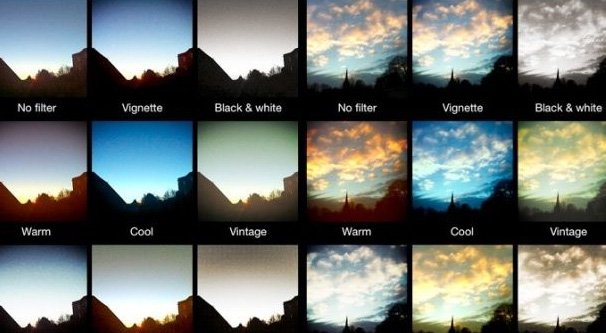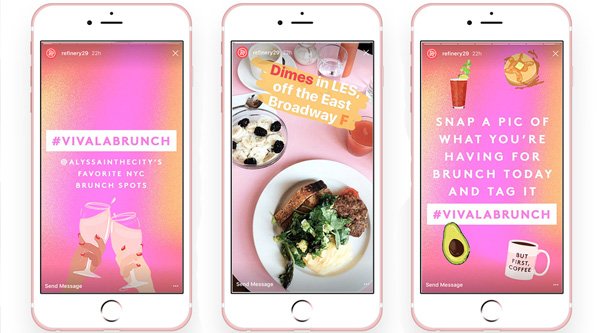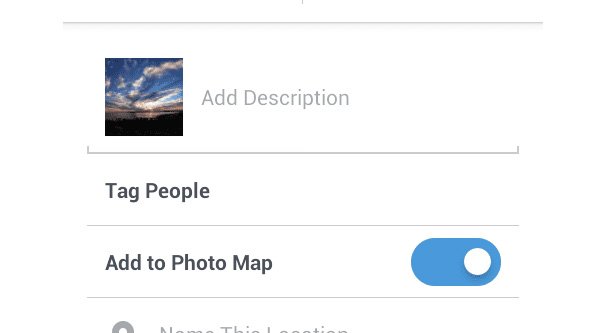What Kind of Posts Can You Auto Post to Instagram?
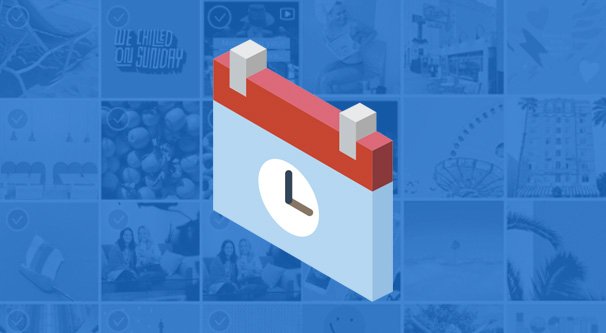
Over the last few years, Instagram has slowly become a more and more accessible platform for marketers. Years ago, it was a walled-off paradise, a utopia of incredible engagement rates, accessible only via their mobile app. Even emulators struggled to access all of its features.
Since then, the site has made a number of changes to make it more open to the public, both for users and for businesses. First they opened up their doors to desktop users, allowing them to make accounts, view posts, and leave comments, though for a while they couldn’t make posts of their own.
Later, Instagram introduced more business features, and allowed desktop users more access to the site.
Now, Facebook and Instagram have taken on a series of marketing partners, third party businesses that have access to the limited Instagram API and can do things like create posts and schedule posts remotely. You didn’t used to be able to post via a third party app; in fact, every app that claimed you could was just using your account information on their own phones.
If you’re interested in using a third party platform, there are quite a few of them available to you now. The full list is available here, and I talked about them some more over here.
Instagram’s API Limitations
The days of a completely closed-off platform only usable on a mobile device may be behind us for Instagram, but that doesn’t mean Instagram is full available to everyone.
In fact, the Instagram publishing API is only available to users who have toggled on the Instagram for Business switch, which converts their account into a business account. Unlike Facebook’s split between profiles and pages, Instagram simply has one account format, with a business flag. It’s easy to turn on; simply go to your profile, tap settings, tap account, and tap “switch to business account.”
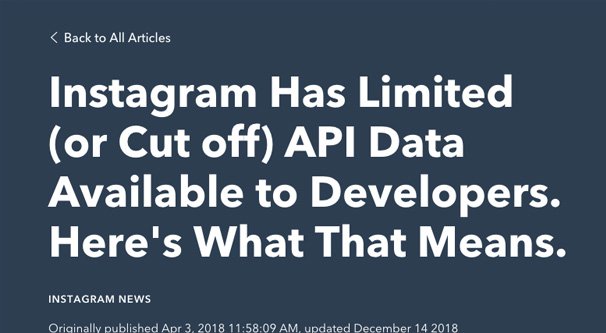
What this does is, basically, just give you access to the API and to Insights. Other business features they may roll out in the future will appear here as well. For now, though, it’s still basically the same as a personal account.
The first limitation for the Instagram API, then, is that it can only post to users who are Instagram business accounts.
The second set of limitations comes from a major change Instagram made last year in response to privacy concerns across their platform. This major API change shut down a bunch of apps and limited the ones that still existed.
- The change killed off a huge array of common Instagram bots. Cheap, basic bots that followed and unfollowed accounts in bulk based on keywords died immediately.
- Many third party analytics apps and competitor analysis apps died as well. The API change removed the ability to see the posts that a person likes; only the account owner can see what the account likes. This actually improves functionality in a sense; users can now use likes as a private way to keep track of posts, without risk of their lists becoming public.
- Follower analysis apps often died as well. The ability to see and analyze the demographics and user information for a list of followers disappeared.
- The ability to use an app to post comments or delete comments became restricted to business accounts. Before, any account could use an app to post comments, but that was largely abused. The new API only allows those actions for business accounts.
This, in general, killed off a lot of low quality or spammy apps, killed off a few more robust and legitimate apps, and restricted many apps to only business customers. Some adapted, others died, and that’s the way of the world when you’re running a business that relies on the goodwill of another business to survive.
Instagram Post Types
Instagram has a handful of different kinds of posts you can make on their platforms. You have your typical image posts, you have multi-image posts, you have stories, you have posts with shopping tags in them, and on and on. So which of these are available, and which are not?
Available: Standard posts. A post with an image and a caption, including hashtags, can be posted via the API just fine. Again, as mentioned above, this is only available to apps that are official Instagram marketing partners, and it’s only available to accounts that are Instagram business accounts. This API endpoint is still available, and I can’t imagine they will restrict it completely, though there are rate limits in place as you would expect from any API.
Available: Standard posts with extra data. The API is allowed to access specific data-tagging features, most notably tagging users and tagging locations. This allows you to use a third party app to create posts that tag specific users, or to create posts that have a geolocation tag attached to them. From a technical standpoint, this simply means including extra data for the ID of the user or the location, but from a user standpoint it simply means using those features in the app you’re paying for.
Available: Standard video posts. Standard posts that use a video rather than an image are available to post via the API. It’s a technical two-step process of submitting the post, getting the container in return, and sending information in the container, but that’s not something a typical user needs to know.
And that, unfortunately for some of you, is pretty much it. You can read the API documentation here if you’re a technical-minded sort, and if you’re reading this more than a year in the future it’s probably worth checking to see if they added anything else. Speaking of, if they did, let me know; I wouldn’t mind updating this post.
That means everything else isn’t available. Let’s give it a rundown.
Not available: Multi-photo or carousel posts. A few apps, like Later, offer the ability to post carousel posts through their app, but they use a workaround to do it. Instagram does not support the ability to create a post with more than one image attached.
Apps like Later get around this by creating a post manually, but requiring you to log in to publish the post. This is the old-school workaround for posting when Instagram had no API, by the way; it was more of a reminder and formatting app than it was a publication platform.
Carousel posts are probably number one on my list of posts Instagram is most likely to allow on their API in the future. They are useful, they draw more engagement than standard posts, and they’re not likely to be technically much different from a normal photo post.
Not available: Instagram filters. One of the core features of Instagram is the ability to apply a quick and easy graphical filter to your images when you upload and post them. However, Instagram does the filter processing on the server side of things, and as such, they don’t want to give it API access. API access for filters would likely cause a lot of extra server and resource strain, and besides, do you really need it?
Most people using brand-level platforms are editing their photos separately before they upload them to Instagram, with a program like Photoshop, rather than using Instagram’s filters. Even if they’re using Instagram’s filters, they might even be using mimic filters from a third party app and just using the filter tag. In fact, this is what Later does. They offer filters based on Instagram’s filters, which you can apply to images before you upload them to Instagram for your posts.
I would be surprised if Instagram chooses to add filters to their API in the future. It’s too much resource consumption for too little benefit, in my mind.
Not available: Instagram Stories. Stories are one of the most engaging formats for Instagram content, but they’re also very complex. They’re made up of multiple images and videos, with additions like stickers to give them more robust information. Due to this complexity, there’s no easy way for Instagram to provide API access to create them. The number of different inputs they would need to accept is too high, and anyways, they want people to use their Stories editor instead of third party editors.
Speaking of third party editors, some of them still allow you to create stories, though they do not publish them directly. Basically, these apps are offering a storyboarding and creation service, but not a publication service. You still need to then manually publish the story on Instagram yourself.
Not available: Drafts. Instagram only has publication as part of their API, and a draft is a saved post, not a published post. This isn’t really a huge loss, though; the purpose of virtually every Instagram platform is to schedule posts, which involves creating them and saving them as drafts to be published later. The drafts are simply stored in the platform you use instead of on Instagram before the API call to publish them is pushed.
Not available: Tags. I mentioned above that you can use a geolocation tag and a hashtag in your API-pushed posts, but those are hashtags, not tags. Tags, in this case, is more like the stickers you can add on top of an image on Instagram.
Branded content tags are actually a very new feature that isn’t even available across the whole platform yet. It stands to reason that it isn’t broadly available to the API, though I don’t imagine they will add it later.
Shopping tags are a bit older and are more common. They allow you to post an image and then tag products in the image, which can be purchased directly through Instagram. Now, you need to have a storefront attached to Instagram, with a catalog and product information available, which means it’s a pretty high bar already. On top of that, only certain kinds of businesses can use shopping tags. Much like Stories, though, it adds a lot of complexity to posts and makes them difficult to push through with an API. Instagram simply chooses not to allow it.
Not available: Extended JPG formats. Wait, what? What even are extended JPG formats? Well, we’re talking about images formatted in a different, well, format, specifically things like MPO and JPS files.
If you don’t know what these are already, it pretty definitely doesn’t matter to you. Specifically, they’re file formats for images used for things like 3D photography. For example, MPO is MultiPicture Object, and is created by digital cameras that snap simultaneous pictures from different lenses to create a 3D or stereoscopic image. JPS is the same thing; a stereoscopic JPG image made up of multiple images.
Instagram does not currently support stereoscopic 3D, and as such, they don’t allow you to post these kinds of images on their API. Again; if you’re not already aware of these files and you’re not using them actively for 3D applications, this limitation doesn’t matter to you.
That more or less covers it. Third party Instagram apps are actually a lot more limited than they often appear, because they use clever workarounds to bypass some of the API restrictions.
Will Instagram’s API change in the future? Almost definitely. Will they add new forms of posts to the API for third party apps to use? Probably. Will everything be available eventually, from Stories to shopping tags to carousels? I doubt it. It doesn’t hurt Instagram to restrict those kinds of posts, so they’ll probably continue to do so.






